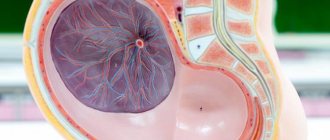Clinic of mitral valve lesions
Severe mitral stenosis leads to severe shortness of breath, which sharply reduces exercise tolerance.
Left atrial pressure almost always exceeds 25 mmHg. Art., the course of the disease is complicated by pulmonary hypertension, atrial fibrillation, thromboembolic syndrome. Atrial fibrillation: occurs with hemodynamically significant mitral stenosis in 80% of cases and can lead to a sharp deterioration of the condition as a result of a sudden increase in left atrial pressure and pulmonary edema. Thromboembolism of the arteries of the great circle occurs in 20% of cases, 80% of such patients have atrial fibrillation. Embolisms are multiple, repeated in 25% of cases; in half of the cases, cerebral artery embolism occurs. With severe pulmonary hypertension (more than 50 - 60 mmHg), survival rate is less than 3 years.
1.What is mitral valve stenosis?
Mitral valve stenosis
, or
mitral stenosis
is a narrowing of the left atrioventricular orifice, which impedes the natural outflow of blood.
The basis of this disease is the thickening of the valve leaflets and limitation of their motor function. Mitral valve stenosis
– a curable heart defect in patients of any age, subject to proper and timely treatment.
A must read! Help with treatment and hospitalization!
2. Causes of stenosis
The mitral valve is located between the left ventricle and the left atrium. It opens in diastole. Arterial blood from the right atrium then enters the left ventricle through the atrioventricular foramen. Blood enters the left ventricle through the mitral valve, which consists of two leaflets. Under blood pressure during contractions of the left ventricle during systole, it closes, preventing the reverse outflow of blood. With mitral valve stenosis, the atrioventricular orifice narrows, which leads to disruption of the flow of blood into the left ventricle from the left atrium.
The main cause of mitral stenosis is rheumatism
– a systemic inflammatory disease that affects the heart tissue and joints. Streptococcal infectious diseases contribute to the development of rheumatism: scarlet fever, tonsillitis, erysipelas, etc. Children aged 7 to 15 years are at risk. In medical practice, there are cases when, despite numerous cases of sore throat, people considered themselves absolutely healthy, but at the same time had scars on the inner lining of the heart - the first sign of fusion of the valves and the development of mitral valve stenosis.
Visit our Cardiology page
Treatment of the disease
Unfortunately, there is no specific conservative therapy for this disease. Drug treatment is aimed at:
- Prevention of rheumatic carditis;
- Antibiotic prophylaxis before invasive procedures (prevention of infective endocarditis);
- Treatment of complications that arise.
Indications for conservative (drug) treatment and its main features
Indications for conservative management of patients with MS:
- I, II and V stages of stenosis (when invasive treatment is not advisable);
- Correction of pulmonary hypertension, rhythm disturbances, hemoptysis, CNC;
- Emergency care for pulmonary edema.
The treatment regimen for MS includes:
- Diuretics;
- Long-acting nitrates;
- β-blockers;
- Anticoagulants;
- Ca2+ channel blockers;
- Antiarrhythmic drugs.
When is surgery used and how is it performed?
Indications for surgical treatment:
- Symptoms of pulmonary hypertension;
- MK hole area is less than 1.5 cm2;
- Asymptomatic with a high risk of thromboembolism;
- Pregnancy planning.
Types of invasive treatment:
Percutaneous mitral commissurotomy is a rupture or dismemberment of fused commissures using a balloon inserted through a catheter through the interatrial septum. It has high efficiency, low risk of complications, quick recovery. Do not use in late stages and intracardiac complications.- Open valvotomy is open heart surgery using extracorporeal oxygenation. It is carried out in the presence of a thrombus in the left atrium, calcification of both commissures, combined heart defects, coronary artery disease with the necessary CABG.
- Anuloplasty (mitral valve replacement) is performed for patients with critical damage to the valve apparatus, NYHA class III/IV. Has a higher risk of complications, mortality comparable to commissurotomy. Compliance with all recommendations of postoperative rehabilitation significantly reduces the above risks.
Symptoms of mitral stenosis
High pressure in the pulmonary arteries in patients is manifested by complaints of shortness of breath during physical exertion, as they cause increased blood flow to the heart muscle and overstrain of the capillaries, as well as the walls of the heart in conditions of atrioventricular valve stenosis. All this leads to difficulty in normal gas exchange, further shortness of breath even at rest and pain in the heart. Obvious pallor of the skin, with a pronounced blush on the cheek with cyanosis , heartbeat and its interruptions, the development of atrial fibrillation is possible.
Visually detectable symptoms of mitral valve stenosis:
- heart hump;
- acrocyanosis – bluish discoloration of the skin, affecting the tip of the nose, ears and chin;
- increased cyanosis and the appearance of pallor of the skin, up to an ashy color during physical activity, usually caused by a high degree of pulmonary hypertension;
- a sharp rise in pressure in the pulmonary circulation can cause cardiac asthma ;
- mitral stenosis may manifest itself as a dry cough or with the discharge of a small amount of mucous sputum;
- with hemoptysis , siderophages or so-called heart defect cells are detected in the sputum.
Symptoms of weakness in combination with increased fatigue are associated with a characteristic fixation of cardiac output, since there is no adequate increase in cardiac output under conditions of physical activity.
In the case of significant stenosis of more than 80%, the patient's condition may be complicated by pulmonary edema , atrial fibrillation , pulmonary hypertension and the occurrence of thromboembolic syndrome .
Diet for mitral stenosis
Diet for heart failure
- Efficacy: therapeutic effect after 20 days
- Timing: constantly
- Cost of products: 1700-1800 rubles. in Week
Mitral valve stenosis is accompanied by the development of heart failure , pulmonary hypertension and an increased risk of thromboembolism , so the lifestyle should be as healthy as possible. It is necessary to exclude any harmful products, as well as alcohol, coffee, strong tea, nicotine or any drugs. In addition to moderate physical activity and avoiding stress, it is recommended to monitor the balance of proteins, carbohydrates and fatty acids, and do not forget about auxiliary vitamin therapy and water balance in the body. It is advisable to cross out from the menu:
- fatty foods, especially those of animal origin;
- roast;
- spicy;
- smoked;
- cholesterol-containing products.
The diet should be enriched with potassium and magnesium salts; it should be based on cereals, fruit, vegetable, milk soups, vegetable side dishes, dishes with cheese, poultry and fish. We must not forget about the regular consumption of berries, vegetable juices, raw fruits, and, of course, citrus fruits, apples, dried apricots, prunes, raisins and grapes. In addition, it is very important to limit your fluid and salt intake.
4. Diagnosis and treatment of mitral valve stenosis
If you notice symptoms of stenosis, you should definitely consult a doctor, as symptoms of stenosis may worsen over time. For example, during significant physical activity and stress. Diagnosis of heart problems begins with a general examination, in particular with auscultation - listening to murmurs in the heart and lungs using a phonendoscope. Based on the data obtained, the doctor decides whether additional examination is necessary. The doctor may prescribe:
- echocardiography - sound examination of cardiac tissue;
- electrocardiography and Holter monitoring;
- chest x-ray;
- cardiac catheterization.
Diagnosis of mitral stenosis is the first step in treating this disease.
, because it is on the basis of the data obtained during the examination that the doctor will draw up an individual treatment regimen for mitral stenosis for you. Currently, there are two main forms of treatment for mitral valve stenosis: surgical and conservative.
- Surgical treatment of mitral valve stenosis involves heart surgery and is not suitable for all patients.
- Conservative treatment of mitral valve stenosis is based on drug therapy and is not able to cure the stenosis directly. But medications can eliminate the complications of this defect: heart failure, arrhythmia, etc.
Treatment of mitral stenosis, like all other heart diseases, is carried out by a cardiologist and includes regular examinations to record indicators of heart condition and monitor the course of the disease. People diagnosed with mitral valve stenosis should understand that this disease will be with them for the rest of their lives. To improve your well-being and prevent complications of heart disease, it is important to take care of your health and undergo regular medical examinations, as well as avoid strong physical and emotional stress and hypothermia.
Classification of types and degrees
The disease is classified according to 2 bases. When diagnosing mitral stenosis, the degree is determined as the area of the mitral orifice decreases. There are 5 successively worsening degrees of the disease:
| Degree | Qualitative definition of stenosis | Mitral orifice area (in cm2) | Clinical signs |
| First | minor | more than 3 | no symptoms |
| Second | moderate | 2,3-2,9 | symptoms of the disease appear after physical activity |
| Third | expressed | 1,7-2,2 | symptoms appear even at rest |
| Fourth | critical | 1-1,6 | severe pulmonary hypertension and heart failure |
| Fifth | terminal | the lumen is almost completely blocked | the patient dies |
Depending on the type of anatomical narrowing of the valve opening, the following forms of mitral stenosis are distinguished:
- “jacket loop” type - the valve flaps are thickened and partially fused to each other, easily separated during surgery;
- “fish mouth” type - as a result of the proliferation of connective tissue, the valve opening becomes narrow and funnel-shaped, such a defect is more difficult to surgically correct.
Stages of the disease (according to A.N. Bakulev):
- compensatory – the degree of narrowing is moderate, the defect is compensated by hypertrophy of the heart, there are practically no complaints;
- subcompensatory - the narrowing of the hole progresses, compensatory mechanisms begin to exhaust themselves, the first symptoms of trouble appear;
- decompensation – severe right ventricular failure and pulmonary hypertension, which quickly worsen;
- terminal – stage of irreversible changes with a fatal outcome.
Clinical manifestations
The symptoms of mitral stenosis do not correlate well with its severity, since in most cases the pathology progresses slowly, and patients involuntarily reduce their activity. Many patients are asymptomatic until pregnancy or the development of AF. Initial symptoms are signs of heart failure (dyspnea on exertion, orthopnea, paroxysmal nocturnal dyspnea, fatigue).
Symptoms usually do not appear until the ages of 15 to 40, when an attack of rheumatic fever occurs. In developing countries, young children may be symptomatic because streptococcal infections may not be treated with antibiotics and recurrent infections are common.
The clinical picture depends on the stage and degree of narrowing of the bicuspid valve. With a narrowing of up to 3-4 sq.cm, there are no complaints for a long time; with critical stenosis (less than 1 sq.cm), complaints are always present. The appearance of a patient with mitral stenosis is characterized by:
- Forced position - sitting with emphasis on the palms.
- "Mitral butterfly" on the face.
- Noisy heavy breathing.
- Marked weakness.
Paroxysmal or persistent forms of atrial fibrillation further reduce blood flow to the left ventricle (LV), causing pulmonary edema and acute shortness of breath with poor ventricular rate control. AFib can also cause palpitations. In about 15% of patients not receiving anticoagulants, systemic embolism with symptoms of stroke or ischemia of other organs may occur.
Less common symptoms include hemoptysis due to rupture of small pulmonary vessels and pulmonary edema (especially during pregnancy when blood volume increases). Hoarseness due to compression of the left recurrent laryngeal nerve by the dilated LA or pulmonary artery (Ortner's syndrome) and symptoms of pulmonary hypertension and RV failure may also develop.
Mitral stenosis can cause symptoms similar to cor pulmonale. A classic sign of the facial condition in MS is cyanotic flushing of the skin, which occurs in cases of low cardiac output and severe pulmonary hypertension; the reason is dilation of skin vessels and chronic hypoxemia.
Sometimes the first symptoms of MS are manifestations of embolism, for example, a stroke. Endocarditis rarely occurs in MS not accompanied by mitral regurgitation.








